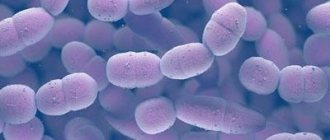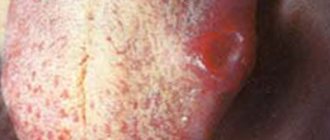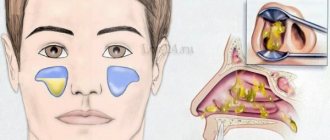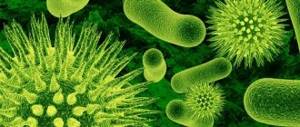Lymphadenitis is inflammation of the nodes of the lymphatic system caused by damage by pathogenic microorganisms. Signs of the disease are enlarged and painful lymph nodes. Lymphadenitis rarely acts as a primary disease; more often it appears as a consequence of any infectious disease in the body. The inflammatory process in the lymph node begins due to the entry of harmful microbes from the primary inflammatory focus into it through the lymph flow: suppuration, boil, etc.
Types and stages of development
When classifying inflammation of the lymph nodes, doctors take into account the causes, location, as well as the duration and characteristics of the course of the disease.
Based on what infection caused it, specific and nonspecific are divided.
Nonspecific lymphadenitis is caused by:
- viruses;
- bacteria;
- fungal flora.
The specific form is a response to the penetration of special microorganisms into the lymph nodes, including:
- actiminocete or radiant fungus;
- treponema pallidum;
- Brucella;
- tuberculosis bacillus;
- tularemia bacterium;
- plague stick.
Penetration of Koch's bacillus into the lymph nodes causes tuberculous lymphadenitis. This form of the disease most often affects the cervical and submandibular lymph nodes, as pathogens enter the body through the oral cavity and nasopharynx. Tuberculous lymphadenitis can infect symmetrical nodes of the lymphatic system.
The duration of the disease underlies the division into chronic and acute forms.
Acute lymphadenitis is characterized by a rapid course of the disease. This form occurs when the body is affected by a general disease, or when the pathogen enters the lymph node directly. Acute lymphadenitis is provoked by an infection with a high degree of contagion.
Chronic lymphadenitis is a consequence of a long-term illness. Also, chronic lymphadenitis may be associated with the development of oncology or the presence of a chronic disease.
Based on the nature of the inflammation, serous lymphadenitis (the primary stage, when symptoms do not significantly manifest) and purulent lymphadenitis (a dangerous form of the disease with vivid symptoms that requires mandatory professional treatment) are distinguished.
Depending on where in the body the inflammation of the lymph node occurred, the following types are distinguished:
- cervical;
- submandibular;
- inguinal;
- axillary;
- parotid;
- mesenteric lymphadenitis.
The development of the disease goes through three stages:
- Simple or catarrhal – initial.
- Hyperplastic - a later stage with an increase in the number of lymphocytes in the inflamed node.
- Purulent is the last phase. Purulent lymphadenitis is characterized by destruction of the lymph node.
Causes
The cause of lymphadenitis can be diseases of the internal organs. Cases when pathogenic microorganisms enter directly into the lymph nodes (when the skin is damaged) occur less frequently. When local disturbances become the cause, it is called reactive lymphadenitis.
One lymph node or several adjacent ones can become inflamed. This form is called regional lymphadenitis.
Lymphadenitis in adults indicates a decrease in immunity. This disease affects children's bodies mainly in preschool age, when the immune system has not yet fully formed.
In addition to the above general reasons, they may be characteristic only of the area of the body where lymphadenitis occurred.
Cervical
Lymph nodes in the neck area become inflamed under the influence of ENT diseases, allergies, metabolic disorders, connective tissue diseases, and suppuration in the neck area. Also provocateurs of inflammation are cancer and HIV.
We also recommend reading the article Which lymph nodes enlarge with HIV?
The danger of this form is its proximity to the throat and nose. With a serious course of the disease, problems with breathing and eating cannot be ruled out, especially in children.
Submandibular
This is the most common form. Inflammation of the lymph nodes occurs against the background of diseases of the facial skin, salivary glands, and oral cavity. May result from acute tonsillitis.
Inguinal
The inguinal type can be provoked by problems in the genital area: inflammation, tumors, STDs, as well as inflammatory processes in muscle tissue and skin, purulent wounds in the perineum.
Axillary
Inflammation in the armpit, like other forms, occurs due to suppuration of the skin or damage by pathogenic microbes: HIV, various cocci, etc. Another cause is hypothermia, which is especially common in summer. In the heat, it is more difficult to protect sweaty armpits from drafts. In women, the axillary form can be caused by mastitis, which often occurs during breastfeeding.
Rarer forms
One of the rare forms is parotid lymphadenitis. The cause of inflammation behind the ears can be contamination of the earlobe piercing, purulent diseases and skin injuries in this area. Lymphadenitis behind the ear is especially dangerous, as it can cause a disease such as inflammation of the brain. Even more information in the review Lymph nodes behind the ears - causes and signs of enlargement
The cause of mesenteric (also sometimes called mesenteric) lymphadenitis is diseases of the upper respiratory tract and tonsils. Mesadenitis mostly affects children; in adults, this form is less common.
The main symptoms of inflammation of the lymph nodes, taking into account localization
Common manifestations of the disease include fever, swelling of the lymph node and redness of the skin at the site of the lesion. The patient has a fever. The number of leukocytes in the blood increases.
At the same time, there are several local symptoms of lymphadenitis. Thus, the cervical type is characterized by pain when turning the head, eating, or talking. The submandibular appearance is characterized by pain when moving the jaw. When the lymph node in the groin is inflamed, the thigh on the affected side swells. A distinctive feature of the axillary form of the disease is swelling and difficulty moving the arm.
Acute nonspecific lymphadenitis
Here the main symptoms will be:
- Enlargement and pain in the lymph node.
- Strong headache.
- Weakness and malaise.
- Increased body temperature.
If we talk about catarrhal lymphadenitis, then with this form of the disease the general condition of the patient can be considered satisfactory, the symptoms are few and insignificant. Although the lymph nodes are inflamed, pain is noted only upon palpation.
As soon as the process enters the form of progression, the signs of the disease become pronounced:
- The pain becomes more severe.
- The skin on the lymph node enters the stage of hyperemia.
- Palpation of the lymph node causes severe pain.
- The nodes are soldered together and surrounding tissues, which leads to their complete immobility.
Important! Complications are possible here in the form of thrombophlebitis, lymphatic fistula and spread of the purulent process to the cellular space.
Diagnostic rules
The International Classification of Diseases, Tenth Revision, assigns code L04 to acute lymphadenitis. According to this classification, nonspecific lymphadenitis has code I 88. Chronic (except mesenteric) lymphadenitis according to ICD-10 has code I88.1.
It is necessary to distinguish between lymphangitis and lymphadenitis. With lymphangitis, the lymphatic vessels become inflamed, not the nodes.
Diagnosis of inflammation of the lymph nodes should be carried out by the attending physician. It determines symptoms and treatment. First of all, the doctor palpates the lymph nodes for inflammation, identifies existing signs and prescribes how to treat lymphadenitis. To determine what stage the disease is at and what caused the disease, the following methods may be required:
- blood test (general, HIV, STI);
- Ultrasound;
- X-ray/CT;
- biopsy of the inflamed lymph node.
More information about the biopsy procedure in the review Is it worth doing a biopsy? Indications and contraindications for the procedure
What are the causes of lymphadenitis
First of all, the causative agent of lymphadenitis is pyogenic microorganisms that penetrate the lymph nodes from the source of inflammation. If we give the disease a certain classification, we can divide it into:
- Purulent and non-purulent lymphadenitis.
- Acute and chronic disease. Determined by the duration of inflammation.
Inflammation can be localized only in one lymph node, or it can affect nearby ones. If they are also purulent, then the result is an extensive focus of suppuration, which is located in the soft tissues. Such a lesion is called adenophlegmon.
Therapeutic methods
Treatment of lymphadenitis is always carried out in a complex manner. It should be aimed both at eliminating the inflammation itself and at the primary disease that caused its occurrence.
Drug therapy
To relieve inflammation of the lymph nodes and cure the root cause of the disease, the doctor prescribes antibiotics, anti-inflammatory and painkillers, as well as immunomodulators. Antifungal and antituberculosis agents may also be prescribed.
Physiotherapeutic procedures
Physiotherapy helps to improve the patient’s well-being, reduce the inflammatory process and restore damaged tissue. To treat this disease of the lymph nodes, the doctor prescribes the following physiotherapy procedures: UHF, laser and galvanization.
Surgical treatment
Surgical treatment is required when inflammation increases. Purulent contents and dead tissue are surgically removed. The intervention is performed under local anesthesia. Drainage is installed for a week.
Treatment of lymph nodes at home
Home remedies can only be used in conjunction with therapy prescribed by a specialist. They are used to boost immunity, relieve swelling and inflammation, provided that this is permitted by a doctor.
Decoctions
Blueberries are good for the immune system. Its berries are poured with water in a ratio of 1 to 4 and left for an hour. Drink 4 teaspoons twice a day.
Nettle flowers can help relieve inflammation. Pour 5 tablespoons of dried flowers into a liter of boiling water and leave for 2 hours. The strained infusion is drunk half a glass in the morning and evening.
Due to its healing properties, dandelion is widely used in folk medicine. For inflammation of the lymph nodes, a decoction of its leaves is used. Take 1 part dandelion leaves to 4 parts water. Take 50 ml half an hour before meals three times a day.
Tinctures
Echinacea tincture is used to increase immunity. For half a glass of water, add from 20 to 40 drops of tincture. Take orally 1-2 times a day.
Echinacea also has disinfecting properties, so its tincture is also useful for compresses. It is diluted in a ratio of one to two. The compress is applied throughout the night.
Rinse
Beneficial properties of tea made from chamomile, calendula and mint. It is taken both as a drink and as a gargle 3-4 times a day.
You can also gargle with a solution of baking soda and salt. Dissolve half a teaspoon of each product in a glass of hot water. Allow to cool and use several times a day.
Compresses
If there is no purulent inflammation, then compresses with dimexide can be used. It is diluted in half with water. Use the compress twice a day for 15 minutes.
A compress made from celandine is common. The leaves are doused with boiling water and applied to the affected area. Keep it for half an hour. Repeat 3 times a day.
Ointments
Due to its antiseptic properties, ichthyol ointment can be used in the treatment of inflammation of the lymph nodes. The ointment is applied to the inflamed area several times a day.
Necrotizing lymphadenitis of Kikuchi. Clinical course and treatment
Kikuchi necrotizing lymphadenitis is usually a self-limited disease that resolves on its own within one to four months. The relapse rate is 3 to 4%. Some patients may develop systemic lupus erythematosus after a few years. When treating the disease, symptomatic measures should be used to relieve symptoms. Antipyretic analgesics and nonsteroidal anti-inflammatory drugs may be used to relieve lymph node tenderness and fever. The use of corticosteroids is recommended in severe cases. Patients with Kikuchi necrotizing lymphadenitis require systematic evaluation and regular monitoring for several years to exclude the development of systemic lupus erythematosus. Cervical lymphadenopathy, as a rule, also goes away on its own, 1-6 months after diagnosis.
Can it be cured forever?
How to treat inflammation of the lymph nodes should only be determined by a doctor. A significant role is played by what caused this disease and its type. It must be remembered that an acute form that is not completely cured can transform into chronic lymphadenitis. Therefore, it is important to consult a doctor and follow the prescribed treatment to get rid of this disease forever.
In the chronic form of the disease, special attention should be paid to prevention: maintaining and restoring immunity.
Necrotizing lymphadenitis of Kikuchi. Etiology and pathogenesis
Bilateral lymphadenopathy (rare in Kikuchi disease)
Today, there are a large number of theories pointing to different reasons for the development of Kikuchi necrotizing lymphadenitis. Most theories point to viral or autoimmune causes. The role of the Epstein-Barr virus, as well as other viruses (HHV6, HHV8, parvovirus B19), in the pathogenesis of Kikuchi necrotizing lymphadenitis remains controversial and inconclusive. Viral infection, however, may be involved in the development of some manifestations of this disease, these manifestations include atypical lymphocytosis and lack of response to antibiotic therapy. Necrotizing Kikuchi lymphadenitis has also been reported in HIV and HTLV-1-infected patients.
On the other hand, electron microscopic studies revealed tubular reticular structures in the cytoplasm of stimulated lymphocytes and histiocytes in patients with this disease. And since these structures are also found in endothelial cells, in lymphocytes of patients with systemic lupus erythematosus and other autoimmune disorders, some researchers have suggested that perhaps Kikuchi necrotizing lymphadenitis may be a self-limited autoimmune disease that is caused by viruses. It is possible that Kikuchi necrotizing lymphadenitis may represent an excessive T-cell-mediated immune response in genetically susceptible individuals to various nonspecific stimuli.










